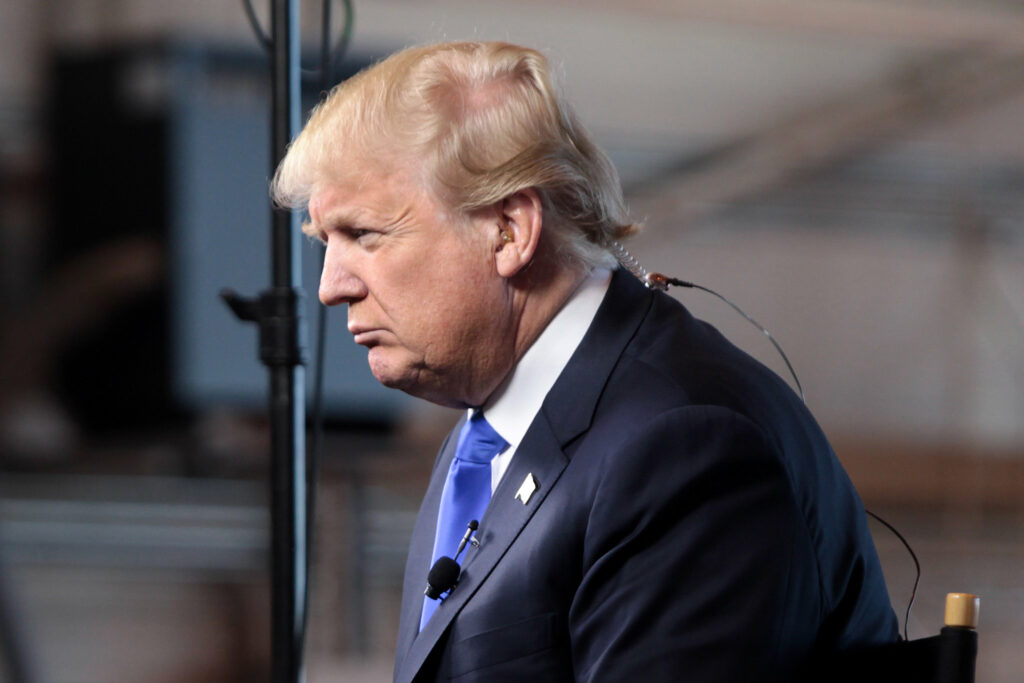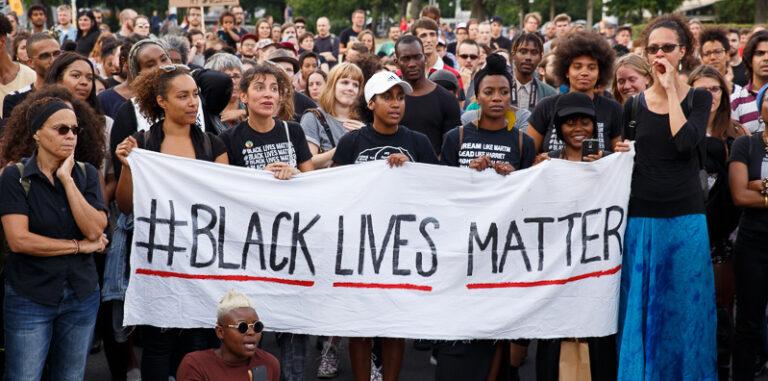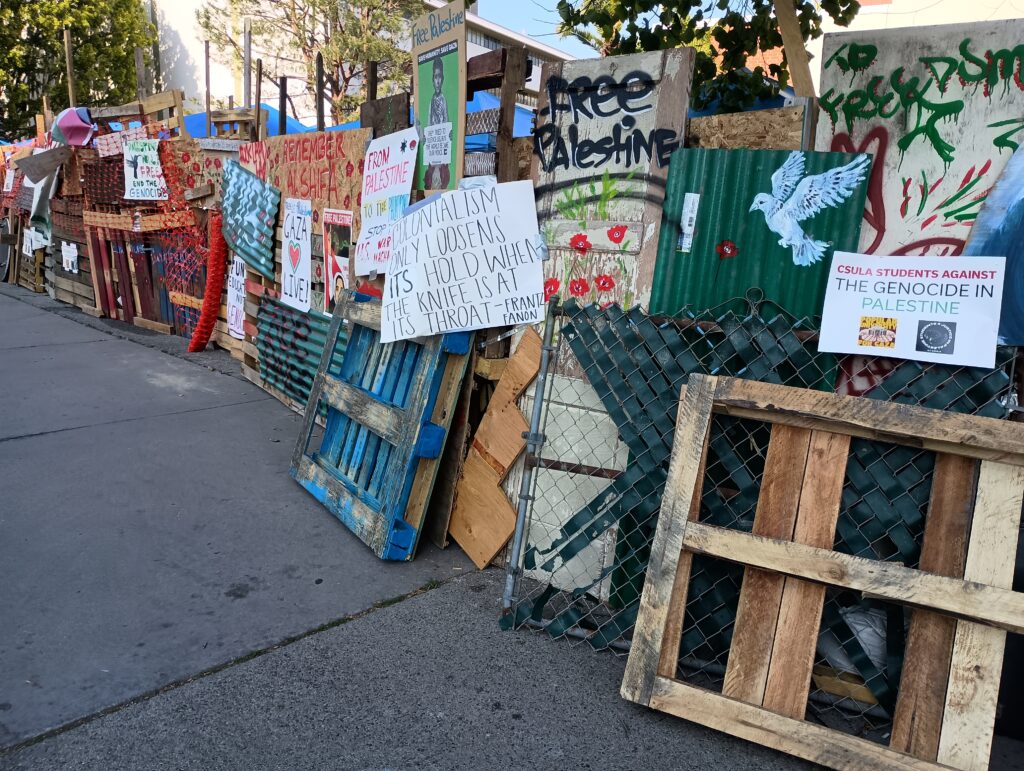
The International Socialist League interviewed Tempest member Aaron Amaral about the state of U.S. politics today and the role of a radicalizing Left in responding to economic crisis, the presidential elections, the labor movement, and the ongoing Israeli genocide in Gaza.
At a certain point in their historical lives, social classes become detached from their traditional parties. In other words, the traditional parties in that particular organizational form, with the particular men who constitute, represent, and lead them, are no longer recognised by their class (or fraction of a class) as its expression. When such crises occur, the immediate situation becomes delicate and dangerous, because the field is open for violent solutions, for the activities of unknown forces, represented by charismatic “men of destiny.”
–Antonio Gramsci, “Observations on Certain Aspects of the Structure of Political Parties in Periods of Organic Crisis,” Selections from the Prison Notebooks, Section II, Chapter 2, “State and Civil Society.”
International Socialist League: We’ve noticed that a common argument, raised in articles on the Tempest website, is that the U.S. Left that has been facing a strategic impasse, in part of its own making. So has the Left internationally, in many respects. How would you describe our current conjuncture?
Aaron Amaral: What we have been witnessing in the United States since the impact of the Great Recession in 2008 (and the efforts by capital and the state to find a way out of that crisis through a flood of cheap money) are continually emerging cracks in a social and political order that continues to strain under the weight of the deep contradictions of world capitalism, the imperialist world order, and the inability of the ruling class institutions to accommodate to those changes and to build any kind of ruling class–led political consensus on the strategies for governance—that is, hegemony.
We have also seen growing right-wing authoritarian challenges to the late neoliberal international order. Like the parallel dynamic of a resurgent left reformism, which had its heyday almost ten years ago, it is critical to root the right-wing populist authoritarian tendencies firmly in an international context. This is a context of economic dislocation animmd social crisis that is unprecedented in the last 40 years. This has led to levels of political polarization and radicalization greater than we have seen in more than a generation.
As David McNally observed recently,
It’s always worth reminding ourselves that all seven major Wall Street banks faced collapse in 2008–09 and that there was genuine trauma in ruling-class circles about whether they could pull off an immediate rescue. Once that happened, I think the best commentators understood that neoliberalism was really fundamentally about a realignment of class power and much less about a hard ideological commitment to never running deficits and never going into debt. In other words, to preserve the existing configuration of class power that characterized neoliberalism (based on weakened unions, depleted social movements, and restored profitability), they would inject unprecedented amounts of stimulus into the system, and they would run enormous deficits to make this happen. While stabilizing the system, stimulus policies also essentially offset capitalism’s inbuilt restorative mechanisms.
Corporate indebtedness is enormous and remains an important threat to any sustainable recovery of profitability in the United States, not to mention the impact of sovereign debt within the less developed capitalist states.
In the post-COVID-19 period, inflation rates started rising rapidly as a result of a confluence of conditions, including crises of classic neoliberal just-in-time distribution chains, investment bubbles in various sectors caused by the the massive flood of cheap money seeking less and less available profitable sectors of investment, and growing instability and conflict in the imperialist world system (and in particular, Russia’s invasion of Ukraine). The response of the world’s banking system, and most importantly the U.S. Federal Reserve, has been to jack up interest rates to levels not seen since the so-called Volcker shock (named after the then-head of the US Federal Reserve bank Paul Volcker), which began in late 1970 and initiated the period of Reaganite neoliberalism in the United States.This is a context of economic dislocation and social crisis that is unprecedented in the last 40 years. This has led to levels of political polarization and radicalization greater than we have seen in more than a generation.
In the last few years, the Federal Reserve’s focus on interest rates has also centrally been driven by ruling-class fears about a tight labor market and the idea that working-class people are gaining undue leverage in that market as the economy has been growing since 2021. In reality, despite the tight labor market, wages relative to inflation have not grown but have continued to fall behind. For working people, and especially for a generation of workers who came into the labor market after 2008, meaning anyone under the age of 35, they feel a profound sense of instability, precarity, and downward social mobility.
This reality can be tracked in a number of ways, but it is a stark reality. There has been a drop in overall life expectancy in the United States. The 0.9-year drop in life expectancy in 2021, along with a 1.8-year drop in 2020, represents the biggest two-year decline in life expectancy since 1921–1923. And after the Indigenous community, Non-Hispanic white people in the United States had the second biggest decline in life expectancy in 2021, one full year from 77.4 in 2020 to 76.4 in 2021. This is significant given the relatively privileged material position of the white community historically in the United States, a relative advantage that includes life expectancy. Relatedly, between 2000 and 2020, the suicide rate increased by more than 40 percent for all ages, spiking notably after 2008. The numbers are particularly egregious for younger workers, especially teenage boys and girls and women in their prime working ages between 25 and 44. The age-adjusted rate of drug overdose deaths has almost tripled in the US between 2008 and 2021.
This is a broader stroke picture of the social landscape here that provides the backdrop to what is happening politically.
ISL: How do you situate Donald Trump’s current presidential bid in this context and that fact that, yet again, we have Joseph Biden and him in a rerun of the last election?
AA: Back in 2018 Sam Farber wrote an article in which he accurately described Trump as a “lumpen capitalist.” Farber was responding to a liberal instinct—or strategy—to psychologize Trump, to delink him from his social context and what he represents. This is not to deny the fact that Trump is likely a certifiable sociopath and malignant narcissist. It is just to put the emphasis where it belongs.
Farber quotes from Marx’s Class Struggles in France, 1848–1850:
Marx wrote that the finance aristocracy of that time “in its mode of acquisition as well as in its pleasures, is nothing but the rebirth of the lumpenproletariat on the heights of bourgeois society.” Marxist scholar Hal Draper clarified that Marx’s “finance aristocracy” did not refer to the finance capital that plays an integral role in bourgeois economy, but to the “vultures and raiders” who swing from speculation to swindling and who are the near criminal or extralegal ex-crescences from the body social of the rich just like the “lumpen proletariat” proper are ex-crescences from the poor.
There is way too much to say about Trump as an absolute hustler, confidence man, and convicted fraudster. There is just as much to say about Trump as the apogee of a rich racist, rapist, and misogynist. But a fundamental issue is how he has his social and political power, and this, in the first instance, grows out of his decades-long role as a lumpen capitalist.

Another key question is how such a figure is able to use that power and then subvert the existing institutions of the capitalist republic at the imperialist core. Or, to turn this on its head, how those existing institutions both accommodate to, and are unable to stop, Trump.
It is without doubt that Trump taps into deep rooted strains of U.S. reactionary politics—chauvinistic isolationism (Make America Great Again), xenophobic know-nothing-ism with fascist overtones that speaks of threats to the “blood of the nation,” the recurring paranoia of the white petit bourgeoisie also feeling the impact of the post-2008 world, and the appeal to the anxieties of millions with “replacement” theories (be it about constructing threats to heterosexuality, masculinity, or hetero-normativity, the Christian nation, to white power, or a mix of it all).
But what most needs unpacking is how Trump and the Trumpite movement have been able to turn these long established strains of U.S. politics into a real threat to the foundational institutions of the capitalist republic, the courts, the representative institutions (Congress, legislatures), and the security establishment itself. Some of the details include the manipulation of the various court cases with which we have become all too familiar in this country. Remember, Trump is currently facing about 90 felony charges, almost all of which in the world of a “rule of law” would stick but which may, in this reality, never be heard.
It is important to understand that when we talk about the U.S. electorate as a whole, the entire political class is wildly unpopular. Both Trump and Biden have negative approval ratings in the double digits. The approval rate of the U.S. Congress is at 12 percent, according to a February 2024 Gallup poll. Gallup likewise rates the Supreme Court to have a nearly 60 percent disapproval rate. And in this context it would be hard to overstate how unwanted a Trump/ Biden rematch is in the broader US population.
If the only vehicle for oppositional politics is seen and understood as either these elections or the reactionary politics of scapegoating offered by the right, we are in for some dark days.
Then there is the debacle that is the 118th Congress, whose closest approximations may take us back to the 19th century, the takeover the Republican National Committee by the Trump family, the corruption of the Wall Street markets by Truth Social, and the role of the broader ecosystem of lumpen capitalism that surrounds Trump. Most significant from the perspective of the state is the slow infiltration and degradation of the vaunted national security establishment and the former ruling class consensus on imperial rule.If the only vehicle for oppositional politics is seen and understood as either these elections or the reactionary politics of scapegoating offered by the right, we are in for some dark days.
Collectively, this speaks to the depths of the weakness of those institutions and their persistent inability to address the frontal attacks on their own constitutional order. It is also intimately linked to the challenges faced by the U.S. state as the imperial hegemon facing asymmetrical challenges to its rule, primarily from China. From the 2016 elections through the spectacles of the Trump presidency–the Muslim travel ban; the formal embrace of neofascists and authoritarians; the unprecedented obsequiousness towards Vladimir Putin, among other authoritarian figures like Viktor Orban, Narendra Modi, Jair Bolsonaro, and Benjamin Netanyahu; attacks on NATO, the embrace white evangelicals, the jailing of migrant children,the loss of abortion rights, the book banning, and the skyrocketing growth of racist violence, assaults, and murders of trans people—the mainstream conceptions of the U.S. liberal republic have been profoundly destabilized.
But at the level of mainstream politics, within those institutions, and within the popular imagination, what has emerged as the alternative to Trump and Trumpism, the Joe Biden–led Democratic Party, should also be of grave concern to the Left. This is not because this so-called alternative is politically equivalent, but because this purported alternative can only at the end of the day serve to strengthen the far right and will only further entrench the populist authoritarian right as a political counter-power—and ironically as the vehicle for anti-establishment politics at the level of the institutions of governance.
So when it comes to the 2024 elections, increasingly, the Democratic Party is reaping what it has sown. There is an increasing alienation from the Democratic Party from key constituencies upon which it relied in the past. This includes younger voters and Black and Latino voters. As the social crisis deepens, the Democratic Party is seen, quite correctly, as defenders of the status quo. And particularly with the ongoing slaughter in Gaza, and the growing movement in defense of Palestine, the stark reality of Biden’s Democratic Party as the first team of U.S. imperialism is making it much harder–if not impossible–for defenders of Palestine (overwhelmingly a multi-racial coalition of younger people and the Arab and muslim community) to vote for “Genocide Joe [Biden].”
At the same time, as the Trumpite movement has consolidated control over the Republican Party, a consistent minority of traditional right-wing voters has refused support. It is undeniable that 15 to 20 percent of Republican voters in state primaries are refusing to vote for Trump. Given the way the U.S. electoral system works, if even a third of those voters refuse to vote for Trump in the general election in November, this can weigh heavily in the outcome.
And while it is not possible to make a realistic prediction on the outcome of the election at this time, what seems clear is that Biden and the Democratic Party will be reliant on building a coalition of the so-called “political center.” This will be based on being the best defenders of the imperialist status-quo and the national security state (i.e. defenders of “our democracy”), increasing belligerence towards China, a nationalist industrial policy tied to imperialist Keynesianism as a selling point to organizer labor, and being the most reliable hands on so-called “border security” (read: scapegoating of migrants). In this, they will be seeking votes from a minority of the Republican Party refugees from Trump and will be running a campaign against this likely-to-be-convicted felon, with the primary message of “look at this madman, at least we are not him.” In this, they will rely on corralling the Left with the quadrennial “lesser-evil” arguments. Whether or not this is a winning electoral strategy, it is one that the Left needs to wholly reject on the basis of both the defense of democratic rights and the fight to strengthen an independent infrastructure of working class resistance to this bleak capitalist future.

ISL: Where do you see the independent Left and Democratic Socialists of America (DSA) in this?
AA: First, we have to talk about the failures and defeats—and I use both words purposely—of a populist reformism electoral politics embodied by Bernie Sanders, the DSA, and the so-called Squad (the group of “progressive” and Sanders- and/or DSA-aligned representatives) to help build a political alternative to the Democratic Party.
To be clear, I am not suggesting that such a strategic outlook ever motivated Sanders and the squad. And while this was a contested question for a period of time within DSA—that is, the idea that building a political alternative to the Democratic Party was a sine qua non for building a left-wing, let alone socialist, political alternative in the heart of world’s imperialist hegemon—it has long since ceased to be contested in any meaningful way.[Seeing the Democrats as a real alternative] can only at the end of the day further entrench the populist authoritarian right as a political counter-power—and ironically as the vehicle for anti-establishment politics at the level of the institutions of governance.
Millions of people looked to Sanders, the Sanders movement, and the DSA as the vehicle—however inchoate—for building a political alternative to the “millionaires and billionaires,” as Sanders likes to say, and were led into a dead end as an increasingly marginal appendage of the Democratic Party. In all the excitement and support for the Sanders movement, we saw incredible naivete on the socialist Left, including its revolutionary wing. Thus far, we have largely failed to win those supporters to seeing the need for a different strategy, one directed away from the centrality of electoral politics to one based on rebuilding infrastructures of resistance within the working class and communities of the oppressed. (However, the current movement n defense of Palestine is raising fundamental questions within the radicalization, albeit in the context of a brutal genocide.)
How the capture of this left-wing energy into the Democratic Party came to pass over the last few years (and continues today) in some ways is a story as old as the Democratic Party, or at least since the emergence of the U.S. socialist movement in the 19th century. However, there are specific stories to be told here that should begin with the kneecapping of Sanders by Hillary Clinton in 2016 and his campaign’s wholesale capitulation in both 2016 and 2020. It would also include the absence of the DSA in any meaningful organized fashion from the biggest social rebellion in U.S. history, the antiracist uprising in the summer of 2020. It would also include the Democratic Party’s role in capturing that movement in the service of the 2020 elections and helping to ensure that the organized legacy of that movement was minimal.
As Haley Pessin wrote in a prescient piece for Tempest at the beginning of 2021, following the concerted efforts of black celebrities and politicians to funnel the energy of the movement into electoral support for Biden:
It was Democrats, however, who blamed calls to “defund the police” for costing them at the ballot box. In a post-election call between Nancy Pelosi and her caucus, Democrats singled out the demand in explaining why they had lost seats in competitive races against House Republicans or had won by slimmer margins than predicted. As a result, some Democrats have considered reversing their support for the George Floyd Justice in Policing Act so as not to risk alienating moderate voters…Later, ahead of Georgia’s Senate runoffs, Biden warned civil rights leaders that painting Democrats as supportive of defunding the police was “how [Republicans] beat the living hell out of us across the country.”
This handwringing echoes attempts by the liberal establishment to discipline the left-wing of the Democratic Party, such as when former President Barack Obama disparaged the demand to defund the police as a “snappy slogan.”
In a similar dynamic to the one described by Pessin, Ashley Smith has described the support of Sanders, AOC, and the squad for Biden’s industrial policy, which he characterizes as “Imperialist Keynesianism.” Smith writes,
Biden designed [this policy] to prepare U.S. capitalism for imperial rivalry with China, ameliorate domestic social inequalities, and neutralize challenges from the Left and especially the Trumpian right. While the administration failed to secure increased spending on social infrastructure, it has implemented a new industrial policy investing in hard infrastructure and high-tech manufacturing to restore U.S. supremacy over Beijing and other rivals.
Biden won the support for this program from most of the union officialdom, NGO bureaucracy, and progressive and socialist politicians. They have helped demobilize struggle with the exception of the new rank-and-file militancy in the labor movement.
[Biden] never intended to implement a neoliberal program and did not adopt Bidenomics, as some on the Left argue, because of pressure from the small U.S. socialist movement, Bernie Sanders, and other left-leaning politicians. Biden and his brain trust developed it to overcome the relative decline of U.S. imperialism.

In the intervening years, the social democratic Left around Sanders and DSA failed to reckon with the impasse caused by its own strategy. To provide just one particularly poignant example, DSA came to the defense of Jamaal Bowman, a DSA member and representative from New York who in 2021 voted in favor of direct military aid to Israel for $3.3 billion and later voted another $1 billion in funding for the Iron Dome, an air defense system that makes it much safer and easier for the apartheid state to bomb indiscriminately the Palestinians living in the occupied territories. Bowman then joined the liberal establishment pro-Zionist group J-Street on a congressional delegation visit to Israel, where he met with the Foreign Minister. Rather than call for his expulsion or suspension, the DSA leadership began a process of suspending its own BDS Working Group (the start of a process that recently led to the working group leaving the DSA altogether). Bowman then left DSA.
And ironically for those holding onto a strategy of tying the Left to the Democratic Party since 2020, the party’s “center,” led by Biden, Nancy Pelosi, and others, has only increased its power. Four years following the second ignominious defeat of Sanders, the political coalition that constitutes Biden’s Democratic Party has taken on the character not of a progressive alternative to Biden buttressed by the energy of Black Lives Matter and as a champion of the 99 percent but rather as the vehicle for capitalist stability and the stalwart defense of the national security state and the imperialist status quo.
Our capacity to build an alternative will not come through a strategy built on electoral politics.
ISL: You just mentioned it in passing, but how would you characterize the mass mobilizing against the genocide in Gaza, and the U.S. role in arming and funding this? How would you situate the recent wave of student encampments in this process?
AA: The movement that has been renewed in the United States following October 7 in Palestine and the genocidal response of the Zionist state has been incredible. Of course, in the context of international solidarity and building a principled anti-imperialist movement, the reemergence of this movement has been incredibly inspiring. It is estimated that in the U.S., as we talk, there have been over 10,00 pro-Palestine protests and actions across the country, involving more than 1.4 million people in more than 920 localities.
In this context, the wave of recent student encampments have been an incredible development, speaking to the depth of the radicalization, the varied—and too often outright repressive – responses by university administrations and the state, and the pressing strategic questions facing the movement, including the relative social power ot students. Nothing of this character–with its spread and militancy–has been seen in the U.S. since at least the anti-apartheid movement in the 1980s, and maybe we have to go back to the 1960s for the best comparisons. And now the cudgel has been taken up by academic workers, including in California with the recent strike authorization, raising the strategic stakes. I encourage people to read Helen Scott’s recent article, which speak to this evolution.

For the movement throughout the country, these are very important advances, given the more than seven months of consistent mobilization in the face of the genocidal assaults. For Tempest we see the desperate need to grow the democratic coalitional organizing spaces that are necessary to build on this movement and to take it into this next phase of the struggle and prepare it for the longer fight for Palestinian liberation. The experience of student encampments, and their spread, show that these spaces are needed and can be built.For the first time since the occupation of Iraq, we are seeing a newly developing, radicalizing Left in the United States rooted in a consciousness of U.S. imperialism and the importance of internationalism and solidarity.
More generally we are seeing people making critical connections between Palestine and labor organizing. I spoke earlier of the particular impact of the post-2008 economic order on younger workers. And this experience of downward mobility of precarity, along with the experiences of the last round of organizing in the movement and Left spaces going back to Occupy Wall Street and Black Lives Matter, has led a new generation of radicalized young people organizing with renewed energy within the labor movement. To be clear, this has not been sufficient to overcome the longer term trajectory or organized labor in the United States, but it has been a consistent source of movement energy and struggle in workplaces across the country. Recent labor struggles, including at Amazon and Starbucks, the railway workers, and more recently with the Writers Guild and Screen Actors Guild, the Teamsters and United Auto Workers, not to mention the continuing organizing and striking of teachers’ unions across the country, are examples of this energy.
You can see the growing support for Palestine within the rank-and-file labor movement in varying support for calls for ceasefire as a basic floor to more advanced demands to heed the call from the Palestinian trade unions who are asking unions to:
- To refuse to build weapons destined for Israel.
- To refuse to transport weapons to Israel.
- To pass motions in their trade union to this effect.
- To take action against complicit companies involved in implementing Israel’s brutal and illegal siege, especially if they have contracts with your institution.
- Pressure governments to stop all military trade with Israel, and in the case of the US, funding to it.
But beyond its importance for international solidarity, this movement has the potential to help guide the Left beyond the impasse presented by the Democratic Party. Given the decades-long centrality of Israel to U.S. foreign policy and the depths with which Zionist politics and support for Israel defines establishment politics, it is hard to envision the type of dynamic that led to the Democrats successfully coopting the energy of Black Lives Matter activists in the run up to the 2020 election.
For the first time since the occupation of Iraq, we are seeing a newly developing, radicalizing Left in the United States rooted in a consciousness of U.S. imperialism and the importance of internationalism and solidarity. This is renewing attention on the importance of breaking out of the cul-de-sac the Left has placed itself in, not only with regard to the Democratic Party, but in understanding electoral politics as the key strategic focus, rather than social movement organizing.
In a similar vein, see have seen a broadening of the horizons of militants within the trade union movement extending beyond the sort of narrow trade union consciousness fostered by that same social democratic Left that has done great work in training a new generation of trade unionists to file grievances, build caucuses, and to be the next generation—for good and bad—of trade union officials, but has done little to nothing to prepare that generation to participate in a broader workers’ and socialist movement. The current movement offers the possibility of just such an advance.








